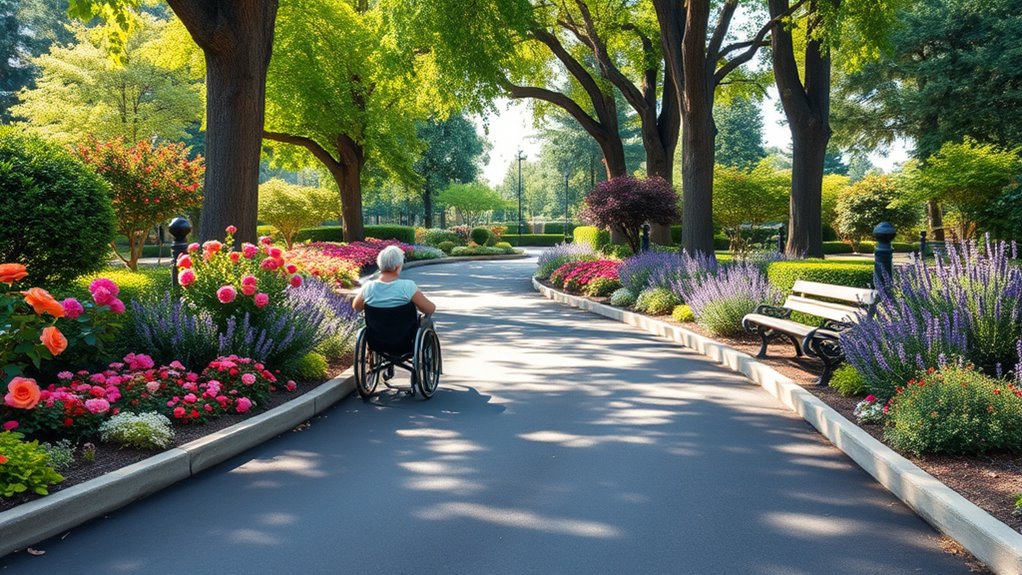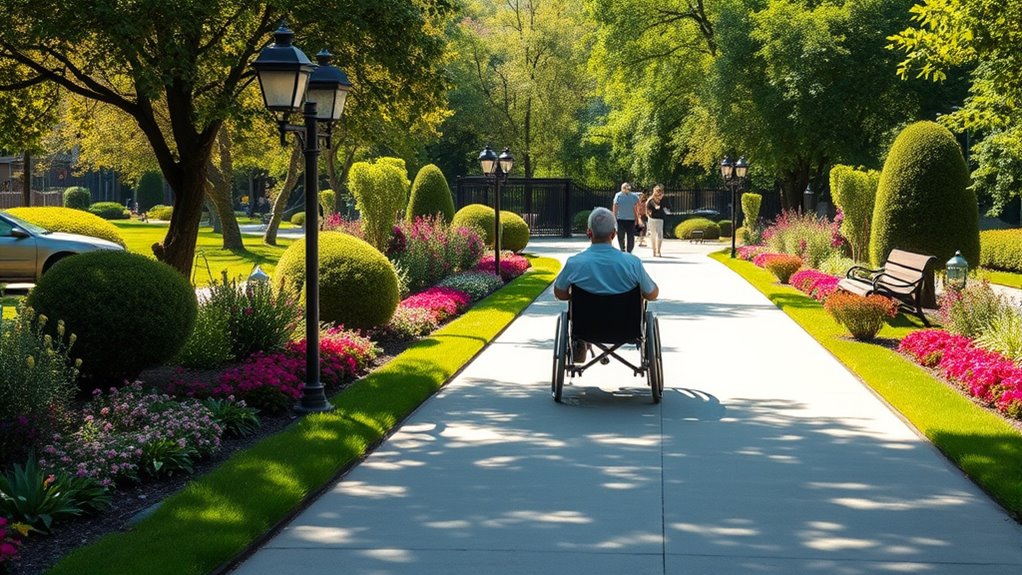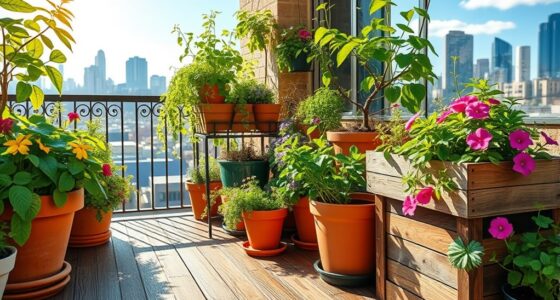To create accessible garden paths, guarantee your walkways are smooth, durable, and slip-resistant. Keep surfaces even and wide enough—at least 36 inches—for easy wheelchair and walker access, with ramps for elevation changes. Use proper lighting and maintain clear surroundings free of obstacles. Incorporate tactile surfaces for the visually impaired and install handrails where needed. These features help make your garden welcoming and safe for everyone, and exploring further can help you design the perfect inclusive outdoor space.
Key Takeaways
- Use durable, slip-resistant surfaces like concrete, textured pavers, or asphalt for safe, stable walkways.
- Ensure pathway widths of at least 36 inches, with 48 inches preferred for easier wheelchair navigation.
- Incorporate gentle slopes with a maximum 1:12 incline and install ramps instead of stairs where needed.
- Install good lighting and keep landscaping clear of obstructions to enhance visibility and safety.
- Add tactile paving or textured strips at key points to assist visually impaired visitors.

Creating accessible garden paths guarantees everyone can enjoy your outdoor space with ease and safety. When designing your garden, it’s essential to prioritize pathways that accommodate all visitors, including those using wheelchairs, walkers, or other mobility aids. A well-thought-out garden design considers not only aesthetic appeal but also practicality, guaranteeing safety considerations are at the forefront. Smooth, level walkways eliminate tripping hazards and make navigation straightforward, creating an inclusive environment where everyone can appreciate the beauty of your garden.
Start by selecting a durable, slip-resistant surface for your paths. Materials like concrete, asphalt, or textured pavers provide stability and reduce the risk of slips, especially during wet conditions. It’s crucial to keep the surface even and free of cracks or uneven sections, which could cause accidents or make movement difficult. When planning the width of your paths, aim for at least 36 inches to allow comfortable wheelchair passage and easy maneuverability. Wider pathways, around 48 inches, are even better if you have larger groups or want to create a more open feel.
Incorporate gentle slopes and avoid steps whenever possible. If elevation changes are unavoidable, install ramps with a gentle incline—ideally no more than 1:12 ratio—to make sure wheelchair users can navigate without difficulty. Handrails along ramps or steep sections can offer additional support, enhancing safety considerations. Good lighting along your garden paths is also essential—bright, evenly spaced fixtures ensure visibility during dusk or cloudy days, reducing the chance of accidents. Consider solar-powered lights for an eco-friendly touch that’s easy to maintain.
Landscaping elements should complement the accessibility features without creating obstructions. Keep plant beds and decorative elements set back from the pathways, ensuring clear and unobstructed routes. When planning your garden design, think about clear sightlines and avoid tightly packed plants or furniture that could block the way. Regular maintenance is key to safety; keep pathways free of debris, overgrown plants, or any objects that might cause someone to stumble. It’s also helpful to include tactile paving or textured strips at key points to guide visually impaired visitors. Additionally, ensuring that support features like handrails and lighting are well-maintained enhances safety for all users. Furthermore, selecting appropriate materials that are both durable and suitable for outdoor use can prolong the longevity of your pathways. Ultimately, creating accessible garden paths isn’t just about meeting safety considerations; it’s about making your outdoor space welcoming for everyone. By choosing the right materials, guaranteeing proper width and slope, and maintaining clear, well-lit pathways, you create an environment where all visitors can explore, relax, and enjoy your garden’s beauty comfortably and safely.
Frequently Asked Questions
What Materials Are Best for Non-Slip Garden Pathways?
When choosing materials for non-slip garden pathways, consider options that guarantee garden path durability and are wheelchair friendly. You should opt for textured concrete, rubber pavers, or natural stone with slip-resistant finishes. These materials provide traction, resist weather damage, and support mobility devices comfortably. By selecting the right surfaces, you create safe, accessible walkways that stand up to the elements and meet your needs for durability and safety.
How Do I Prevent Weeds From Growing Through the Path?
To prevent weeds from growing through your garden path, you should focus on effective weed control and planting strategies. Start by laying a high-quality weed barrier fabric underneath your path materials to block weeds. Then, choose plants that suppress weed growth nearby. Regular maintenance, like pulling weeds early and applying mulch, also helps. Consistent weed control and smart planting strategies keep your walkway clear and beautiful.
What Is the Average Cost to Install Accessible Garden Paths?
When considering the cost to install accessible garden paths, you’ll want to factor in cost considerations like materials, size, and complexity. The installation process involves preparing the ground, laying a stable base, and adding a smooth, durable surface such as concrete or pavers. On average, expect to spend between $1,500 and $4,000 for a standard pathway, but prices can vary based on your project’s specific requirements and local labor rates.
How Do I Maintain a Wheelchair-Accessible Garden Walkway?
Did you know that well-maintained walkways reduce accidents by 30%? To keep your wheelchair-accessible garden path in top shape, regularly check for uneven spots and repair any damage promptly. Add garden edging to define the path and prevent overgrowth. Incorporate lighting solutions to enhance visibility at night, making your walkway safe and inviting. Consistent maintenance guarantees smooth, secure access for everyone, year-round.
Are There Eco-Friendly Options for Creating Smooth Walkways?
You’re wondering if eco-friendly options exist for creating smooth walkways. Absolutely, you can choose sustainable materials like recycled gravel, permeable concrete, or compacted decomposed granite to craft eco-conscious designs. These options reduce environmental impact while providing durable, smooth surfaces. By opting for eco-friendly materials, you support sustainable practices and create accessible, environmentally responsible walkways that blend seamlessly with your garden’s natural beauty.
Conclusion
By crafting smooth, accessible garden paths, you open a world of wonder for every visitor—like a gentle stream that guides all to explore. These walkways become the veins of your garden’s heartbeat, inviting everyone to wander freely and feel connected. With just a little care, your garden transforms into a welcoming oasis where joy flows as effortlessly as sunlight, making every step a journey of discovery and delight for all who enter.









